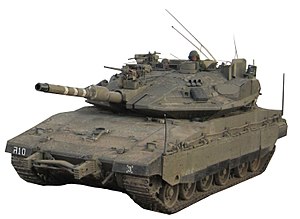Merkava
| Merkava | |
|---|---|

Merkava Mk 4M Windbreaker, fitted with Trophy Active Protection System, during Operation Protective Edge 2014.
|
|
| Type | Main battle tank |
| Place of origin | Israel |
| Service history | |
| In service | 1978–present |
| Used by | Israel Defense Forces |
| Wars | 1982 Lebanon War, South Lebanon conflict, First Intifada, Second Intifada, 2006 Lebanon War, Gaza War, Operation Pillar of Defense, Operation Protective Edge |
| Production history | |
| Designer | MANTAK |
| Manufacturer | MANTAK/IDF Ordnance Corps (assembly) |
| Unit cost | $4.5 million (Merkava IV) (2014 price for sales to other countries) |
| Produced | 1978–present |
| No. built |
Mark I: 250 Mark II: 580 Mark III: 780 Mark IV: 360 in service + 300 units being delivered. |
| Specifications | |
| Weight | 65 tonnes (143,000 pounds) |
| Length | 9.04 m or 29.7 ft (incl. gun barrel) 7.60 m or 24.9 ft (excl. gun barrel) |
| Width | 3.72 m or 12.2 ft (excl. skirts) |
| Height | 2.66 m or 8.7 ft (to turret roof) |
| Crew | 4 (commander, driver, gunner, and loader) |
| Passengers | Maximum 6 passengers |
|
|
|
| Armor | Classified composite/sloped armour modular design. |
|
Main
armament |
120 mm (4.7 in) MG253 smoothbore gun, capable of firing LAHAT ATGM |
|
Secondary
armament |
1 × 12.7 mm (0.50 in) MG 2 × 7.62 mm (0.300 in) MG 1 × 60 mm (2.4 in) internal mortar 12 smoke grenades |
| Engine | 1,500 hp (1,119 kW) turbocharged diesel engine |
| Power/weight | 23 hp/tonne |
| Payload capacity | 48 rounds |
| Transmission | Renk RK 325 |
| Suspension | Helical spring |
| Ground clearance | 0.45 m (1.5 ft) |
| Fuel capacity | 1,400 litres |
|
Operational
range |
500 km (310 mi) |
| Speed | 64 km/h (40 mph) on road 55 km/h (34 mph) off road |
The Merkava (Hebrew: ![]() מרכבה , "chariot") is a main battle tank used by the Israel Defense Forces. The tank began development in 1973 and entered official service in 1978. Four main variants of the tank have been deployed. It was first used extensively in the 1982 Lebanon War. The name "Merkava" was derived from the IDF's initial development program name.
מרכבה , "chariot") is a main battle tank used by the Israel Defense Forces. The tank began development in 1973 and entered official service in 1978. Four main variants of the tank have been deployed. It was first used extensively in the 1982 Lebanon War. The name "Merkava" was derived from the IDF's initial development program name.
Design criteria include rapid repair of battle damage, survivability, cost-effectiveness and off-road performance. Following the model of contemporary self-propelled howitzers, the turret assembly is located closer to the rear than in most main battle tanks. With the engine in front, this layout is intended to grant additional protection against a frontal attack, especially for the personnel in the main hull, such as the driver. It also creates more space in the rear of the tank that allows increased storage capacity and a rear entrance to the main crew compartment allowing easy access under enemy fire. This allows the tank to be used as a platform for medical disembarkation, a forward command and control station, and an infantry fighting vehicle. The rear entrance's clamshell-style doors provide overhead protection when off- and on-loading cargo and personnel.
It was reportedly decided shortly before the beginning of the 2006 Lebanon War that the Merkava line would be discontinued within four years. However, on November 7, 2006, Haaretz reported that an Israeli General staff assessment had ruled of the Merkava Mark IV that "if properly deployed, the tank can provide its crew with better protection than in the past", and deferred the decision on discontinuing the line. On August 16, 2013, Israeli Defense Minister Moshe Ya'alon announced the decision to resume production of the Merkava main battle tank for the IDF Armored Corps.
...
Wikipedia
